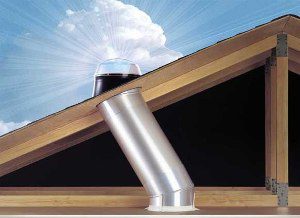
The term ‘solar tube‘ can be used to describe two very different objects. A solar lighting tube is used to bring additional natural light into a building, while a solar heating tube, (also known as a solar thermal collector) is a type of solar panel that can be used to provide heating for residential and commercial properties.
Solar Lighting Tube
A solar lighting tube is a metal tube that is used to transport natural light into a building from outside. The solar tube effectively provides light to poorly lit areas of a building, or areas which would otherwise not receive any natural light.
The idea was originally developed by the ancient Egyptians, but it wasn’t until the 1850s that the French company Chappuis Ltd. patented the idea of using various forms of angled mirrors to bring additional natural light into a building. After the destruction of the Chappuis factory in 1943, the patent lapsed and it was only when an Australian company Solatube International rediscovered the idea in 1986 that solar tubes were again used in modern buildings.
Design
Natural light is collected at the top of the lighting tube using a domed, transparent cupola that collects sunlight and reflects it into a reflective metal tube. The cupola is usually situated on the roof or an outer wall of the building. Many cupolas have a Fresnel lens, directional collectors or additional reflectors to capture more directional light. The metal itself tube is lined with a reflective material a that leads light through the building to the intended area. The most efficient solar tube designs are short and straight, as longer or angled tubes can cause some loss of light intensity. A diffuser at the end of the tube spreads the light evenly into the room.
An innovative design was developed by the Queensland University of Technology in Brisbane, Australia in 1993. In this design, an acrylic panel redirects sunlight into a horizontal or vertical reflective pipe. The pipe contains a triangular light-
Cost
Solar lighting tube kits cost in the range of US$180.95-
Parts
Separate parts for solar lighting tubes are also available from Amazon.com. Items such as a 48-
Reviews
Solar lighting tubes are generally very well reviewed. Most systems received good or very good ratings. A range of reviews can be found here.
Advantages
The main advantage of solar lighting tubes is that they reduce energy consumption. They do not require electricity to function and they have better heat insulation properties than conventional skylights. Solar lighting tubes can also benefit those who suffer from seasonal affective disorder (SAD) because they increase the amount of exposure to natural light.
Kits
A range of solar tube lighting kits can be purchased at Amazon.com. Installation of the kits requires some basic building knowledge and the appropriate tools.
Water Heating –
Another type of solar tube is a called a solar thermal collector. This is a kind of solar ‘panel’ is used for heating water and space heating. The tube collects electromagnetic radiation (heat) from sunlight and converts it to a useable form using a heat exchanger. Solar thermal collectors can be used to generate heat for domestic and commercial uses.
Design
There are two main types of STC design: the Evacuated Heat Pipe Tube (EHPT) and Glass-
In EHPT systems, metals such as copper and aluminum are used to make the internal heat pipes because of the efficiency of their heat conduction. Copper is the most efficient conductor of the two metals, and less susceptible to corrosion, but its high cost means that aluminum is a cheaper alternative. The hot end of the metal pipe is brought into contact with a heat transfer liquid such as a glycol mix, and this liquid then passes through a heat transfer system called a manifold. The manifold is insulated and waterproofed to protect it from adverse weather conditions. Water is then heated by the indirect contact with the glycol in the manifold, and is stored in an insulated water tank.
Glass-
Solar thermal collector tubes are often considered more energy efficient than flat plate solar collectors first developed in the 1950s by Hottel and Whillier. The vacuum inside the outer layer of the STC tube greatly reduces energy loss due to conduction and convection, which means that STC tubes can be more effective than flat plate solar collectors in colder climates. In warmer climates, the high efficiency of the STC tubes means they are mainly used in commercial ventures such as solar power stations.
Domestic STC tubes are typically arranged in rows along a roof, with a range of 10-
STC Tube Heating Kits
Kits are available from many different solar tube heating companies across the world. Amazon.com provide a range of options, depending on the size and number of tube panels required.
Cost
STC Tube Heating Kits are more expensive than solar panels, with prices starting at US$215.99 for a basic solar collector kit from Alibaba.com. More expensive kits include an electrical back-
Parts
A range of parts, such as additional STC tubes, water tanks and pump stations are available from Amazon.com and Alibaba.com as well as a number of other retailers.
Reviews
STC tubes have generally received positive reviews. A comprehensive review of STC tubes can be found at Solar Panels Plus. A clear guide to operation of solar tube collectors, including how to decide the size of solar tube collectors required can be found at Apricus.com.
